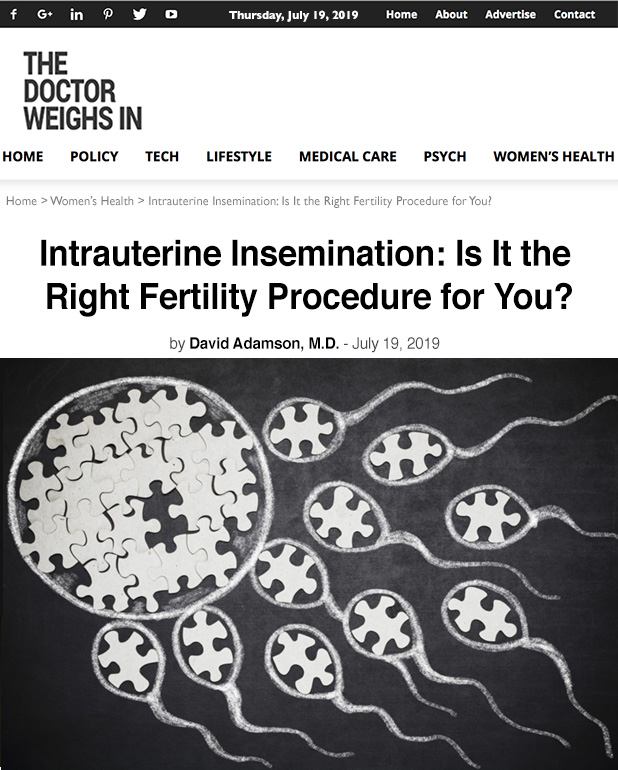Intrauterine Insemination — a fertility procedure in which sperm are placed directly into the uterus using a catheter passed through the cervix-is the right choice for some. Here’s why.
Everyone’s heard of IVF, but what is IUI? It’s “intrauterine insemination” a type of insemination that has been performed for decades. For some women, it may also be a better option to try before IVF.
In vitro fertilization (IVF) is the most effective, and usually final, infertility treatment. While commonly performed, it is used far less than some other simpler treatments. Since many factors determine the best treatment for any given patient, it is important to consider all options.
While age and fertility diagnosis may be the major considerations for selecting a treatment, there are other factors to consider including demands of treatment and cost. It’s worth comparing IUI and IVF to see which might be best for you and your partner.
What is intrauterine insemination?
Intrauterine Insemination (IUI) is a fertility procedure in which sperm that have been washed in a laboratory to concentrate the most active sperm are placed directly into the uterus using a catheter passed through the cervix. While historically also called “artificial insemination,” the term “artificial” is no longer used because it is inaccurate and pejorative.
The insemination is performed at or just before a woman is ovulating. This may be either during a natural cycle or one in which oral or injectable ovarian stimulation fertility medications are used.
IUI for male and female infertility is often suggested by doctors as one of the first fertility treatments. This is because it is relatively simple, cheaper and increases pregnancy rates when performed with ovarian stimulation.
Who is a good candidate for IUI?
Different factors affecting both women and men make IUI a good first option.
-
For women:
IUI is often the first treatment considered for polycystic ovarian syndrome (PCOS) or other ovulation problems because fertility medications make cycles more regular. IUI can also increase pregnancies in women with mild endometriosis or unexplained infertility.
IUI is also a good option for women with cervical abnormalities including scarring from prior surgery or abnormal development of the cervix or vagina. These abnormalities can impair passage of sperm from the vagina to the uterus.
IUI is often recommended for overweight or obese women. Some fertility clinics have a BMI limit for performing IVF because of surgical and other risks.
Along with the conditions described, IUI is a good option for women who have:
- At least one unblocked and reasonably normal fallopian tube
- A normal uterine cavity
- Regular ovulation with or without the help of fertility medication
- A healthy ovarian reserve, that is, a reasonable number of healthy eggs
IUI is not recommended for women with:
- Moderate to severe endometriosis
- Severe disease of the fallopian tubes
- A history of pelvic infections
- Longstanding (>4 years) infertility
-
Male issues:
IUI is a good option if a partner has normal sperm or mild male infertility factor including a below-average sperm count, motility problems or mildly abnormal sperm morphology. It is also helpful if there are ejaculation problems. IUI is not usually successful with severe male infertility.
IUI is also a good option after male fertility preservation for men who have frozen their sperm before cancer treatment or surgery that might affect their fertility. This only applies, however, if their female partner is a good candidate for IUI. And, if there’s a sufficient quantity of frozen sperm available to use for IUI with enough left for IVF if IUI is unsuccessful.
And, IUI is often used by couples where the male has a genetic defect that is managed by using donor sperm
-
For Women and Men:
IUI is often tried first – along with medications to stimulate the development of 2 or 3 mature eggs – for those with unexplained infertility. This diagnosis affects one out of every five couples with fertility issues.
IUI is a good option and commonly used by those without fertility problems, including same-sex couples and single women, who need to use donor sperm. Lesbian couples often use IUI with donor sperm. Male couples may use their own sperm and have their gestational carrier (surrogate) use IUI. And single women who use donor sperm most often use IUI.
What is the success rate for IUI?
Success rates with IUI depend on age, the reason for infertility, whether fertility drugs are used and how many cycles are performed.
IUI pregnancy rate in women less than age 35 is about 8% to 10% per cycle. The cumulative pregnancy rate (total pregnant) after two cycles is about 18% and with 3 cycles about 25%.
Pregnancy rates decrease after 3 unsuccessful cycles. After 6 cycles of ovarian stimulation and IUI, the cumulative or the total number of women pregnant is about 35%. By age 38 or older, pregnancy rates per cycle are usually 5% or less.
For couples with unexplained infertility, IUI is double the success rate of no treatment.
How much does intrauterine insemination cost?
IUI costs range from $500 – $4,000 depending on what’s included and where you live.
Total costs vary by the following factors:
- whether fertility drugs are used (clomiphene is cheaper than gonadotropins)
- if monitoring is used ($500-1,000)
- whether donor sperm is needed
- if a second IUI will be performed on successive days.
A patient will also need ultrasounds, lab tests, and semen analysis.
Insurance may or may not cover some or all IUI costs. Some insurance policies require several unsuccessful IUI cycles before they will cover IVF. Check with your employer to learn about your specific coverage including whether there are any state mandates that require some form of coverage.
Also, some fertility clinics may offer IUI packages for one or multiple cycles using different fertility drug options – oral or injectable. That may also include the necessary office visits, ultrasounds, and blood work.
What are the advantages, disadvantages, and risks of IUI?
IUI for male and female infertility is relatively safe, easy and non-invasive. It is also much faster and less costly than IVF.
The major disadvantage of IUI is the significantly lower live birth rate than IVF.
Also, while taking fertility drugs is safe, there can be side effects – clomiphene can cause:
- headaches,
- hot flashes,
- fluid swings and
- mood swings in some women.
However, most women tolerate clomiphene quite well.
The primary risk of IUI when done with ovarian stimulation is multiple pregnancies. Multiples carry risks for mother and babies including premature birth, disability, infant mortality and health issues for the mother.
Twins can occur in up to 30% of pregnancies with gonadotropins which is why gonadotropins and IUI are rarely done together now. However, this risk can be substantially reduced if only 2 – or at the most, 3 – mature follicles are created during ovarian stimulation.
When limited to 2 or 3 eggs ovulated the twin rate is about 8% to 10%. And the triplet rate is 1 in 200. It is important to note that the multiple pregnancy risk comes primarily from the ovarian stimulation of multiple follicles, not the IUI itself.
Decisions to make if selecting intrauterine insemination
As with most medical treatments, there are decisions to make along the way. With IUI these include, but are not limited to:
- Whether to use fertility drugs and if so, which ones?
- Whether to have monitoring
If monitoring is selected, one must choose either a fertility clinic or ob-gyn to provide the services.
A fertility clinic is considered the best option for monitoring for several reasons:
- better daily monitoring to track and adapt cycle treatment as needed;
- the ability to perform insemination on the weekend if ovulation occurs;
- and better expertise in washing sperm.
Fertility clinics can also treat with gonadotropins if needed, but this is rarely done now.
To learn more, contact Creating a Family – the National Infertility Education and Support nonprofit. To learn more about whether IUI or IVF is right for you, click here to listen to a radio show with an expert (one hour).
When to Stop IUI and try IVF
Before you begin IUI, it’s a good idea to have a conversation with your partner and doctor about how many cycles you want to attempt. Many physicians place a limit of three failed IUI cycles, but others may try up to six before moving on.
This article was originally published on The Doctor Weighs In.


